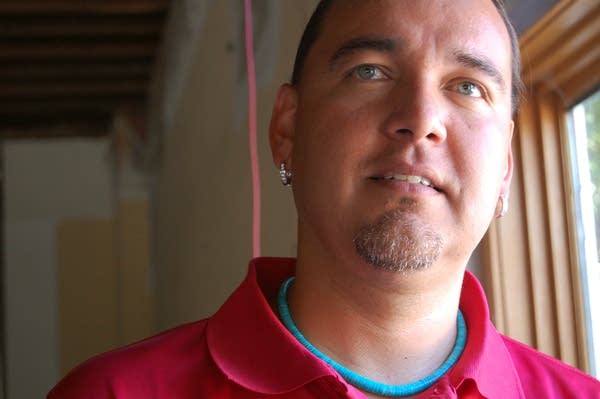Franklin Avenue plan would create urban Indian cultural corridor
Go Deeper.
Create an account or log in to save stories.
Like this?
Thanks for liking this story! We have added it to a list of your favorite stories.

Orange banners that say "American Indian cultural corridor" recently went up along a small stretch of Franklin Avenue in Minneapolis. They're the first step in a project that organizers hope will change the street's tough reputation, and make it a national attraction.
The goal is to re-brand the traditional heart of the city's Native American community as a place where both Indians and tourists can enjoy Native American food, art, and culture.
Justin Huenemann, a father of four with a youthful face and long black hair, is the man who has been the driving force behind the effort to transform Franklin Avenue. Huenemann was raised on a Navajo reservation in rural Arizona. He first set foot in this area about 20 years ago.
"It's sort of where people go when you want to see other Indians, and hang out and catch the latest gossip and all that good stuff," he said. "But I also know that at one point, it was the rough side of town."
Turn Up Your Support
MPR News helps you turn down the noise and build shared understanding. Turn up your support for this public resource and keep trusted journalism accessible to all.
With the nearby Little Earth housing complex, the area has one of the highest urban concentrations of Indians in the country. In the 1960s and '70s, it was at the heart of the American Indian Movement. When Huenemann moved to Minnesota in the early 1990s, Franklin had a reputation for poverty and crime.

Huenemann attended the University of Minnesota, and since then has worked for local Indian-focused nonprofit organizations. He founded the Native American Community Development Institute about four years ago. It essentially works as a liaison between other nonprofits working on Indian issues.
Nearly all of the organizations are clustered on Franklin Avenue.
"We're the largest landowner in this area. All the way down, it's all American Indian owned. It's unheard of," he said. "You just don't see that in any other urban city, that the Indian community owns that much property."
But, Huenemann laments, that there are few businesses along this stretch that are owned by Indians.
"The primary employer in this community tends to be nonprofit organizations. Unfortunately, this community doesn't have a viable economy," he said.
Huenemann is working with other nonprofits to pool resources so they can buy properties along Franklin that can then house for-profit businesses.
"Land is power. If we own the land, we get to be the architects of our own destiny."
He says it isn't easy to get organizations that often compete for the same grant dollars to work together. But they've been swayed by Huenemann's argument that land ownership offers a path to prosperity.
"Land is power. If we own the land, we get to be the architects of our own destiny," he said.
Huenemann says property can create a foundation that could allow the Indian community to climb out of a cycle of dependency.
"Much of the agenda, particularly in the nonprofit sector, is driven by external funders. In other words, if you want money they tell you how you'll do it," said Huenemann. "And the funding does not necessarily support self-sufficiency, self-determination. It supports further dependency."
Huenemann brought community members together to create a blueprint for a new Franklin Avenue, with sculpture- and tree-lined streets, Indian-owned boutiques and restaurants, and a planetarium that focuses on indigenous cosmology.
People arriving by car, bike or light rail might see a play at an American Indian theater or stay at an Indian-owned hotel. Along the way they may pass a pow-wow in a park or a new school for Indian youth. They could also stop in at Indian cafes, where elders gather to tell stories.
"That is what, in essence, we're sort of thinking about -- little Italy, Chinatown," he said. "This would be the first we know of -- the first urban Indian destination corridor in the country."
Hueneman walks into a one-story building with concrete floors and low ceilings. His organization just bought the building with another nonprofit group, and they hope to open an Indian art gallery in the space within the next six months.
"I can't remember the last time two nonprofits purchased anything together," he said. "We pulled it off ourselves."
Other Indian leaders along the street acknowledge that the cultural corridor may be a long way off. But they say simply agreeing on a vision was a big step, and now it's just a matter of putting the pieces in place.




